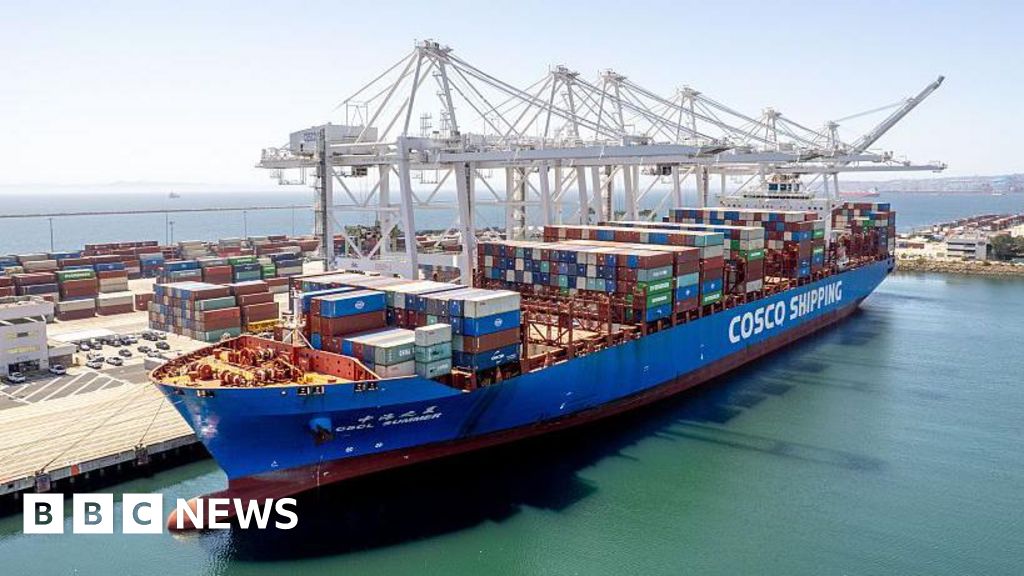The Trump administration has unveiled its plan to impose port fees on Chinese ships as it tries to revive shipbuilding in the US and challenge China’s dominance of the industry.
The US Trade Representative’s (USTR) announcement is less severe than a plan floated in February to hit vessels produced by China with fees of up to $1.5m for each American port they visited.
It said the fees would start to be charged in 180 days time and would rise in the coming years.
There have been concerns that the measures would further disrupt global trade amid US President Donald Trump’s tariff policies.
“China has largely achieved its dominance goals, severely disadvantaging US companies, workers, and the US economy,” the USTR said in statement.
Fees on Chinese vessel owners and operators of ships built in China will be based on the weight of their cargo, how many containers they carry or the number of vehicles onboard.
For affected bulk vessels, the fee will be based on the weight of their cargo, while the charge for container ships will depend on how many containers a vessel is carrying.
Under the measures, fees on Chinese ship owners and operators will initially be charged $50 per ton of cargo, rising by $30 a ton each year for the next three years.
Fees on Chinese-built ships will start at $18 a ton or $120 per container and also rise over the next three years.
Non-US built ships carrying cars will be charged $150 per vehicle.
The fee will be applied once per voyage on affected ships and not more than six times a year.
The USTR also decided not to impose fees based on how many Chinese-built ships are in a fleet or based on prospective orders of Chinese ships, as it had originally proposed.
Empty vessels that arrive at US ports to carry bulk exports like coal or grain are also exempt.
The USTR said a second phase of actions will begin in three years to favour US-built ships carrying liquified natural gas (LNG). These restrictions will rise incrementally over the following 22 years.
The announcement came as global trade is already being disrupted by Trump’s trade tariffs, experts have said.
Cargoes originally destined for ports in the US from China are instead being redirected to European ports, a trade group said.
Businesses have warned this will raise prices for US consumers.
Since returning to the White House in January, Trump has imposed taxes of up to 145% on imports from China. Other countries are facing a blanket US tariff of 10% until July
His administration said this week that when the new tariffs are added on to existing ones, the levies on some Chinese goods could reach 245%.
These tariffs have caused “significant build ups” of ships, especially in the European Union, but also “significant congestion” at UK ports, according to Marco Forgione, director general of the Chartered Institute of Export & International Trade.
More containers are coming to the UK, he said.
“We’ve seen a lot of diversion of ships from China, that were due to head to the US, diverting and coming to the UK and into the EU.”
In the first three months of 2025, Chinese imports into the UK have increased by about 15% and into the EU by about 12%.
“That’s a direct impact of what President Trump is doing,” he said, adding that uncertainty and increased disruption pushes up prices for consumers.
Sanne Manders, president of logistics firm Flexport, said both tariffs and strikes at ports in the Netherlands, Germany and Belgium in the first three months of the year had been “clogging” ports.
Congestion in the UK “is particularly severe in Felixstowe”, while in continental Europe Rotterdam and Barcelona are “also pretty severe”.
“I do believe that if more cargo is going to be routed towards Europe, finding new buyers that will drive up the volumes even further, that could lead to more congestion,” he said – although terminals would be open for more hours per day in the summer due to better weather.
He said shippers were looking for new markets, but that also there may be a surge of goods to the US to try to take advantage of that 90-day window for goods from some countries.
He said in the US, consumers would pay for the tariffs, but European consumers would not see “much impact”.
Companies would also probably start redesigning their supply chains, he said.



